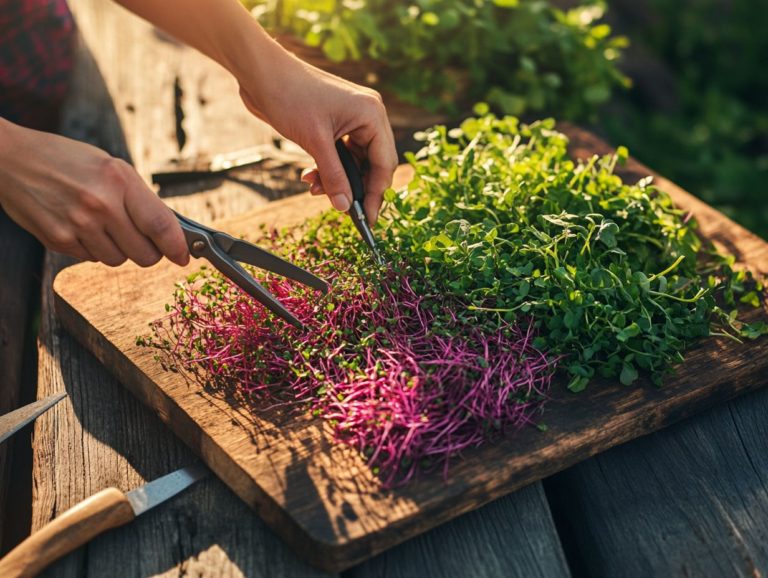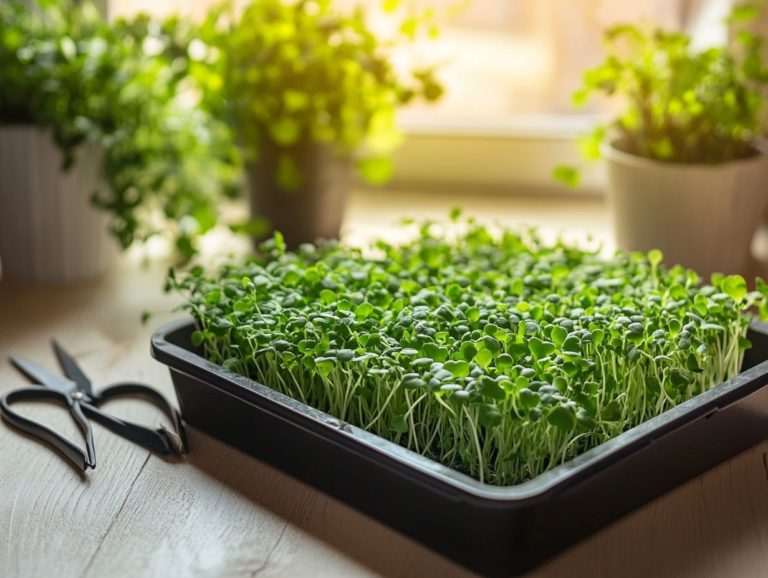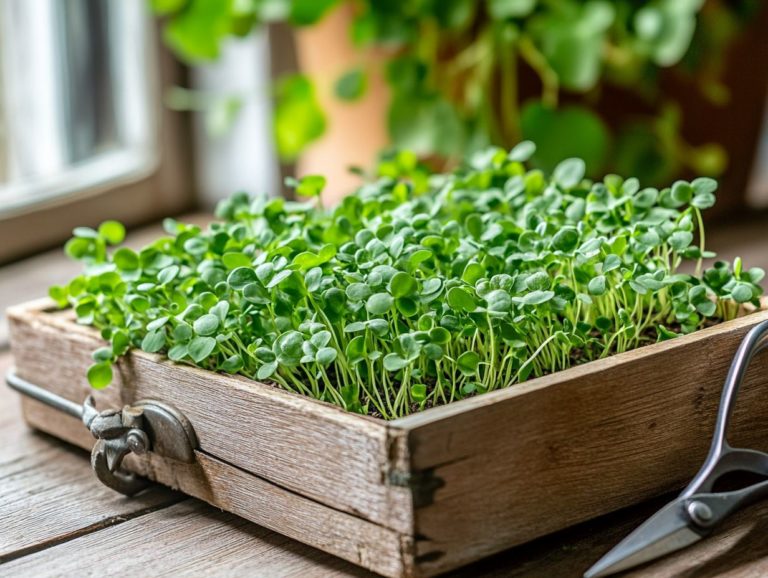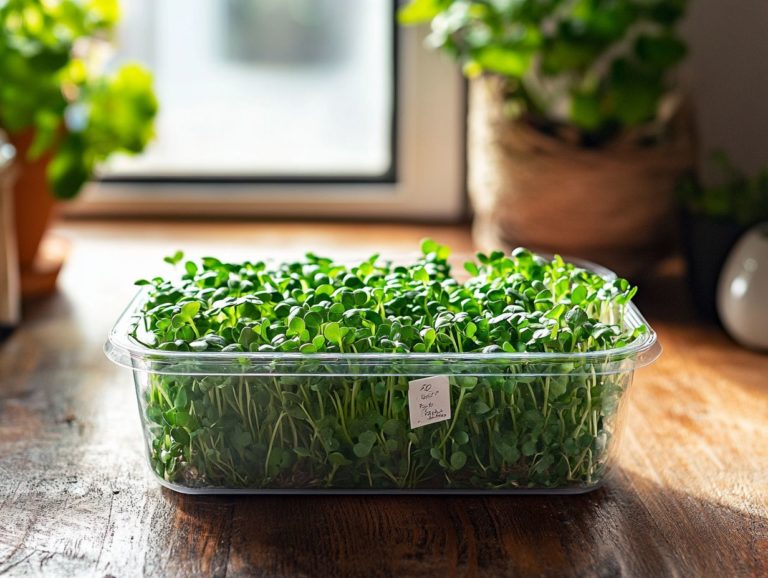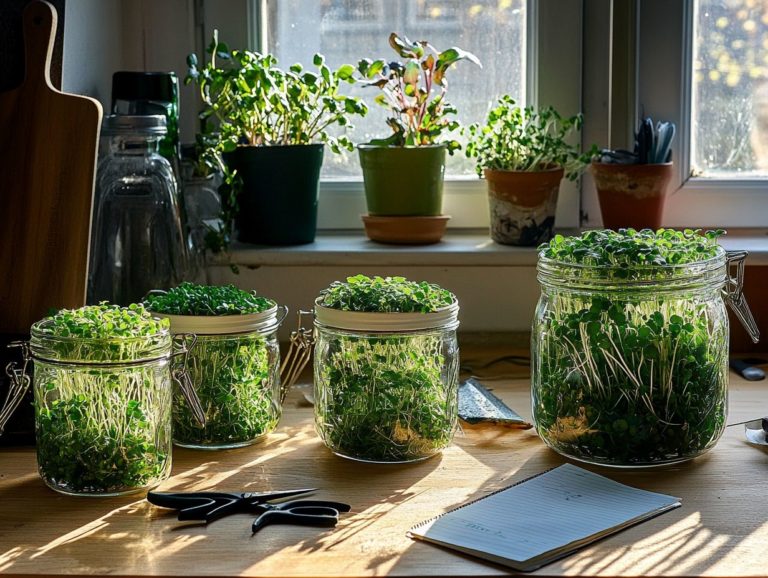How to Harvest Microgreens in Small Spaces
Microgreens are tiny plants. They are nutrient-dense powerhouses that elevate the flavor profile of any dish, making them a versatile addition to your cooking.
They re surprisingly easy to grow and thrive even in the smallest of spaces, making them ideal for urban gardening and anyone with limited room to work with.
This guide will walk you through the essentials of microgreens, highlighting their numerous health benefits while providing practical tips for successful cultivation in small spaces.
You ll discover how to select the right containers for seed starting, grasp their light and temperature requirements, and master the best harvesting techniques to incorporate these vibrant greens into your meals.
You will also explore popular microgreen varieties and innovative ways to integrate them into your cooking with fresh greens. Jump in and transform your home gardening today!
Contents
- Key Takeaways:
- What are Microgreens?
- Growing Microgreens in Small Spaces
- Light and Temperature Requirements
- Harvesting Microgreens
- Popular Microgreens to Grow
- Creative Ways to Use Microgreens
- Frequently Asked Questions
- What are microgreens and why should I grow them in small spaces?
- What do I need to start growing microgreens in a small space using sustainable gardening practices?
- How do I harvest microgreens in small spaces for optimal freshness?
- When is the best time to harvest microgreens in small spaces?
- How should I store harvested microgreens in small spaces?
- Can I continuously harvest microgreens in small spaces?
Key Takeaways:
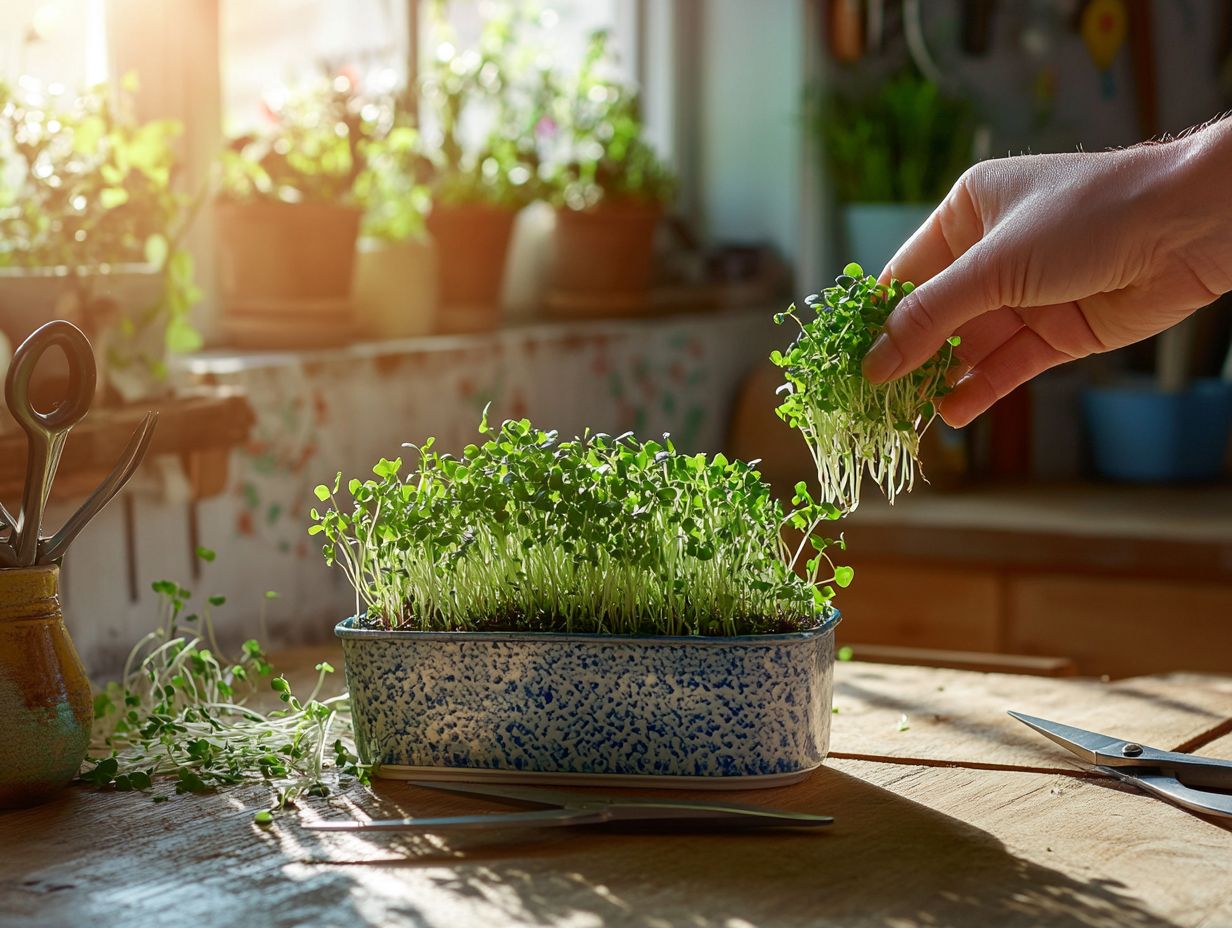
- Microgreens are young, nutrient-dense plants that can easily be grown in small spaces like apartments and balconies.
- Choosing the right containers, soil, and providing adequate light and temperature is crucial for successful microgreen growth.
- Harvesting microgreens at the right time and using proper cutting and storing techniques can ensure maximum flavor and freshness. Try incorporating microgreens into meals for a creative and nutritious boost.
What are Microgreens?
Microgreens are the young seedlings of edible plants, meticulously harvested right after the first true leaves emerge. They provide a vibrant and nutrient-rich enhancement to a variety of dishes.
These petite greens are not only bursting with flavor but also brimming with vitamins and minerals that play a vital role in a healthy diet. This makes them an ideal choice for anyone passionate about sustainable gardening and urban living.
Definition and Benefits
Microgreens are the nutrient-rich seedlings of various plants, celebrated for their vibrant flavors and remarkable health benefits, making them a splendid addition to your culinary repertoire.
These delicate greens are loaded with vitamins and minerals, often boasting up to 40 times the nutrients of their mature counterparts. By incorporating microgreens into your dishes, you not only elevate the nutritional profile but also enhance visual appeal and introduce a burst of unique flavors that can transform even the simplest meals.
With options ranging from the peppery zest of arugula to the sweet notes of basil, the variety available invites you to experiment and craft signature dishes that truly tantalize the palate. The plethora of health benefits associated with microgreens like improving digestion and supporting heart health establishes them as an critical element of a balanced diet.
Growing Microgreens in Small Spaces
Growing microgreens in small spaces is not only feasible but also incredibly rewarding. You have the opportunity to engage in indoor gardening and enjoy the benefits of fresh greens right in the comfort of your home.
With the right techniques for growing microgreens year-round, you can cultivate a thriving microgreen garden on your window sill, balcony, or countertop. This endeavor enhances your culinary experience and contributes to food accessibility and sustainable practices.
Choosing the Right Containers and Soil
Selecting the right containers and soil is paramount as you embark on your microgreens journey, directly influencing the success of your seed starting and the overall growth of your crops.
You ll find that choosing from a variety of container options can be both enjoyable and practical. For example, reusing egg cartons offers an eco-friendly solution, providing just the right depth for seedling development while ensuring effective drainage.
Alternatively, small plastic trays or even repurposed takeout containers can work wonders, provided they have proper drainage holes. Pair these containers with high-quality potting soil, rich in nutrients, to nourish your plants as they sprout.
Exploring various gardening methods, such as hydroponics, a method of growing plants in water without soil, or soil-based systems, can elevate the growth of your vibrant microgreens. Additionally, learning how to rotate crops for microgreens paves the way for a bountiful harvest with minimal effort.
Light and Temperature Requirements
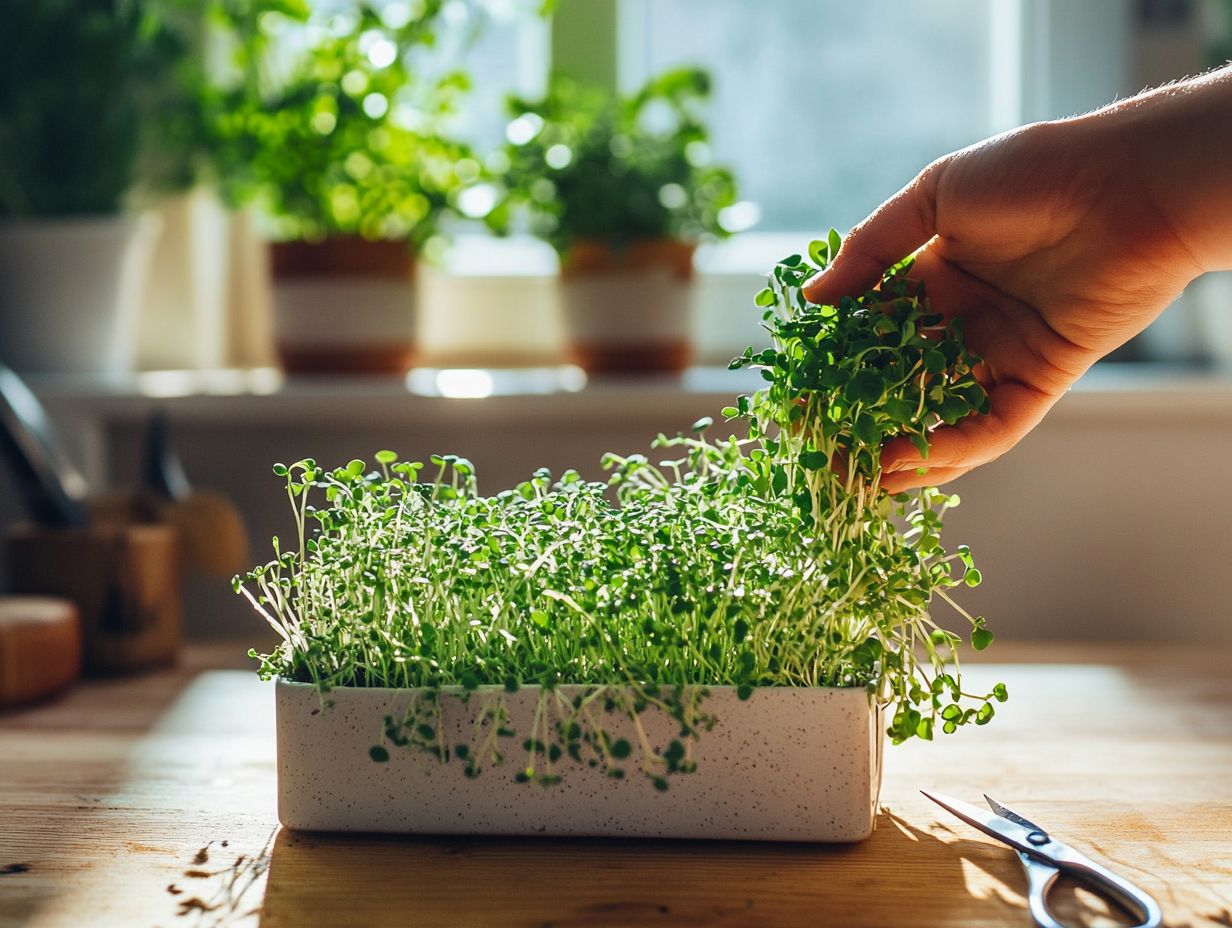
Knowing the right light and temperature can make or break your indoor microgreen garden! These elements significantly influence healthy crop growth and nutrient content.
Providing adequate light whether from natural sunlight or efficient artificial grow lights is essential to achieving the vibrant green color and robust flavor you desire in these petite delicacies. Aim for full-spectrum lights for about 12-16 hours each day to mimic their natural environment.
Temperature is equally important; the optimal range for germination typically falls between 60 F to 75 F, creating perfect conditions for sprouting. Consistent watering practices are key to maintaining the right moisture level, ensuring that your tiny plants receive the hydration they need without the risk of becoming waterlogged.
Harvesting Microgreens
Harvesting microgreens at just the right moment is essential for maximizing their flavor and nutrient content. Understanding when to harvest and using the proper techniques will elevate your indoor gardening efforts, ensuring you achieve the finest results possible.
When to Harvest
Knowing when to harvest microgreens is crucial for you, as they can go from seed to harvest in just 7 to 21 days after germination, depending on the variety and your taste preferences.
Timing can impact not only the flavor profile but also the nutrient density of these delicate greens. For instance, varieties like radish microgreens achieve their peak spiciness around two weeks, while others, such as basil or cilantro, develop optimal flavors just a few days later. To enhance your growing experience, consider using sprouting trays for microgreens, which can help you cultivate these greens more effectively.
By understanding the specific growth stages of each microgreen, you can maximize their nutritional benefits. These greens are not merely a flavorful addition to your dishes but also rich in vitamins and minerals. To optimize your harvest, consider exploring how to maximize yields from microgreens. Look for thick stems and vibrant leaves to know when it’s time to harvest.
Proper Techniques for Cutting and Storing
Utilizing proper techniques for cutting and storing microgreens preserves their freshness and ensures that their remarkable health benefits and flavors are maintained until you re ready to enjoy them.
To achieve optimal results, use sharp, clean scissors or a sharp knife when cutting, as this minimizes damage to the delicate plants. A clean cutting board provides a stable surface and helps prevent contamination.
Ideally, you should harvest microgreens when they reach a height of about one to three inches. This timing allows their vibrant flavors and nutrient profiles to fully develop. For those looking to get started, following a step-by-step guide to sowing microgreens can be very helpful. After cutting, gently rinse them in cold water and pat them dry with a clean paper towel.
For storage, place your microgreens in a breathable container lined with a damp paper towel. This helps retain moisture and prolongs their shelf life while keeping that satisfying crunch and nutrient density intact. If you’re interested in enhancing your growing techniques, consider learning how to use hydroponics for microgreens. This meticulous approach not only maximizes their flavors but also preserves their beneficial compounds, making microgreens a delightful addition to your meals.
Popular Microgreens to Grow
Exploring the world of microgreens opens up a rich tapestry of options for you to cultivate. Here are some popular microgreens you might enjoy growing:
- arugula
- basil
- broccoli
- peas
- kale
- mustard
- radish
- sunflower
Each of these microgreens packs a unique flavor punch that can elevate any dish, making them a fantastic choice for healthy eating and gourmet meals. To grow these greens efficiently, check out how to use a grow tent for microgreens.
Types and Their Uses

Each type of microgreen brings its own unique flavors and health benefits to the table. They transform your culinary creations from simple salads to exquisite gourmet dishes into something truly special while supporting sustainable gardening practices.
Take basil microgreens for example. They add a delightful sweet and peppery essence that perfectly complements Italian recipes and fresh pesto. Radish microgreens deliver a spicy kick that can elevate your sandwiches and tacos to new heights. If you prefer a milder, earthy flavor, beet microgreens are an excellent choice. They introduce a vibrant splash of color and pack essential nutrients like folate and potassium. For those interested in growing these nutritious greens, check out this guide on how to start a microgreen garden for beginners. Sunflower microgreens offer a satisfying crunch and a nutty taste, making them perfect for smoothies or as a topping for salads.
The beauty of microgreens lies in their versatility. They can seamlessly enhance your dishes while providing a wealth of vitamins and antioxidants. If you’re interested in growing them even during the colder months, check out these tips for growing microgreens in winter.
Creative Ways to Use Microgreens
Discover fun ways to incorporate microgreens into your meals! Not only do they elevate the visual allure of your dishes, but they also significantly enhance their health benefits. These tiny greens present a simple yet effective solution for healthy snacking, allowing you to dive into tasty, nutritious options with ease.
Incorporating Microgreens into Meals and Recipes
Incorporating microgreens into your meals is a simple and powerful way to enhance flavor and create visually stunning dishes that encourage healthy eating.
These tiny greens are bursting with essential vitamins and minerals, making them an effortless addition to salads, sandwiches, and even main courses. Picture this: tossing a handful of radish microgreens on a vibrant quinoa salad not only amps up its nutrient profile but also introduces a delightful peppery crunch that tantalizes your taste buds. Plus, exploring the benefits of growing microgreens vertically can enhance your gardening experience!
Sunflower microgreens as a topping for your avocado toast add a nutty complexity that beautifully complements the creamy texture. By weaving these delicate greens into your everyday meals, you can savor a healthful boost while bringing an exciting splash of color and flavor to your dishes. Try adding them to your next meal for a burst of flavor and nutrients!
Frequently Asked Questions
What are microgreens and why should I grow them in small spaces?
Microgreens are young plants harvested for their nutrient-dense leaves. They are easy to grow indoors in small spaces, making them a perfect addition to any kitchen.
What do I need to start growing microgreens in a small space using sustainable gardening practices?
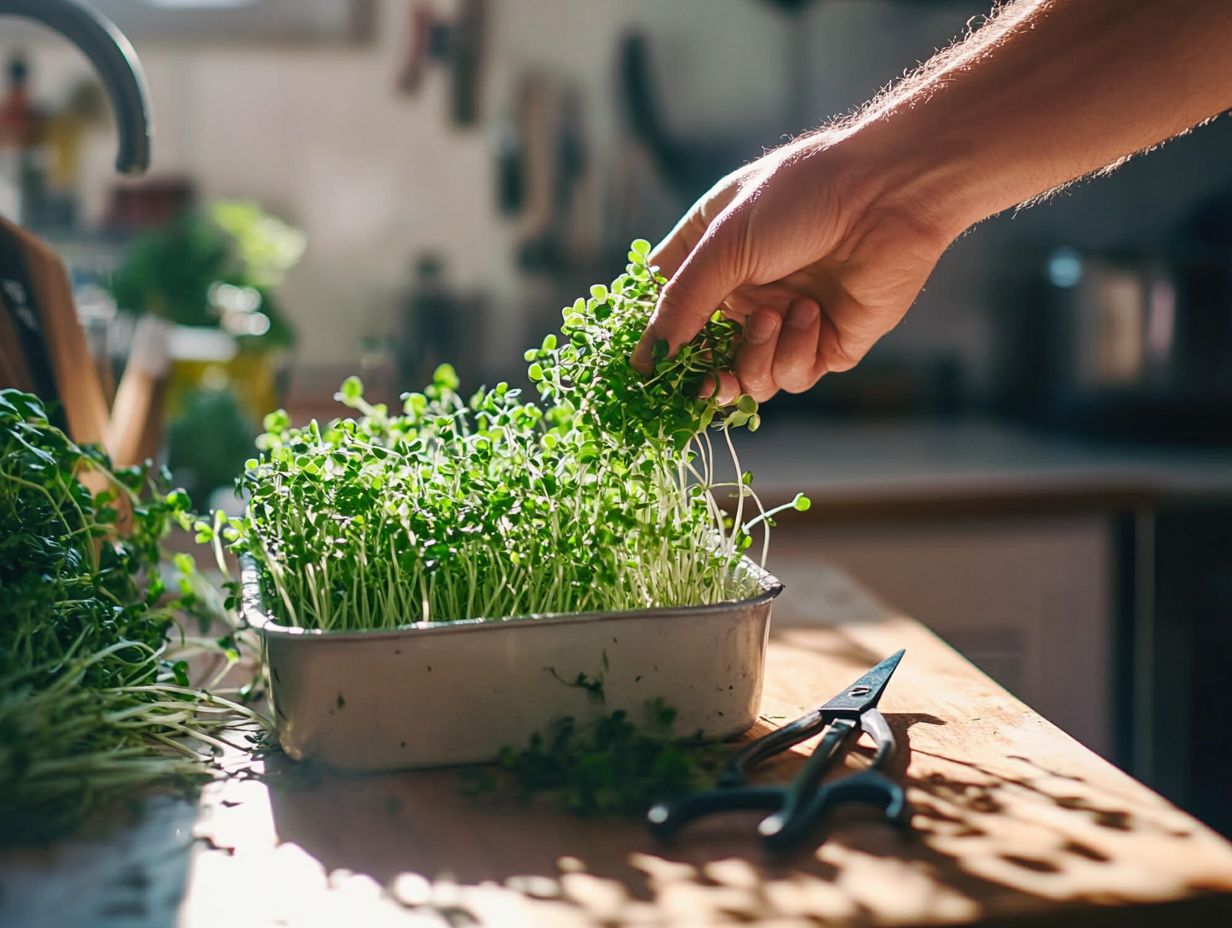
All you need is a container, potting soil, seeds, and water. A grow light can also help your microgreens grow faster and healthier.
How do I harvest microgreens in small spaces for optimal freshness?
To harvest microgreens, use a clean pair of scissors to snip the leaves close to the soil level. You can also gently pull the leaves out from the base if they are easily detached.
When is the best time to harvest microgreens in small spaces?
The best time to harvest microgreens is when they have developed their first set of true leaves, usually after 7-14 days of growth. The leaves should be about 1-2 inches tall.
How should I store harvested microgreens in small spaces?
To store harvested microgreens, place them in an airtight container or plastic bag and store them in the refrigerator. They can stay fresh for up to a week.
Can I continuously harvest microgreens in small spaces?
Yes, you can continuously harvest microgreens by cutting off the top 1-2 inches of the plants. This allows the remaining stem and leaves to continue growing for multiple harvests.

